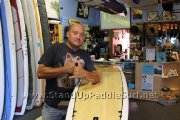SUP Surfing Board Bottom Configurations by Len Barrow
I was at Blue Planet Surf checking out their new line of SUP and surfboards and was able to get Len Barrow from the Zen Waterman Blog share his knowledge on bottom contours and configurations on surfboards and SUP surfing boards. Len explains vee, concaves and gives some history on what has brought us to the modern surfboard bottoms.

(click thumbnail to launch video)
Bottom Configurations
by Len Barrow
What’s Up With Bottom Configurations?
If you are a beginner surfer or surf SUPer bottom configurations may seem most perplexing. They seem complex yet the basics are quite simple. For our purposes here the bottom refers to the entire bottom plane of the board. If you want to examine what type of bottom you have just flip your board over wax or track, side down. Run you had horizontally from one tip of the rail to the other at the midsection of your board. Does the board express a V shape or does the board express a concave shape? Make a careful mental note of this. Repeat this process every twelve inches as you move to the nose. Go back to the center of your board and do this again except move toward your tail. Presto! You have just mapped out your bottom configuration.
You may find that at some areas of your board are almost flat while other areas are heavily veed. Some of you may surprisingly find two double concaves dug out of this plane in your board. The question arises: what does this all mean to your surfboard or SUP’s performance characteristics? The following article will answer these questions.
V Bottom Configuration
Vees were the first in bottom variation and were innovated by the indigenous Hawaiians. It was often thought that early Americans such as Tom Blake in the 1940’s created the vee configuration but in fact it was the native Hawaiians. There are examples of 150 year old boards with veed bottoms in the Bishop Museum of Hawaii. This is an interesting subject yet it shall be left for another article
How does the vee function? Imagine a see-saw with to children on them. If the lower child applies force via his legs to lift off the ground, this child rapidly and efficiently rises; conversely the higher child quickly drops. With a see-saw force is rapidly shifted in a predictable manner. This see –saw effect is crucial to modern surfing in which requires precise and efficient redirections of energy. This effect allows Kelly Slater to do his rapid direction changes. If you watch professional -surfers closely, they are tipping the board from side to side in a see-saw motion to create momentum and utilizing the vee for quick direction changes. Vee is literally the reason that modern surfboards are able to do what they do today.
To put it simplistically, bottom Vees allow you to tip the board on the rail to “cut” in one direction or another. One may also use the vee to “bottom turn” off your rail to do an off the lip. Vee also functions to tip the board from side to side. Again, this enhances the boards maneuverability and speed by allowing rapid directions changes. Next up are concave bottoms!
Concaves
Bottom Concaves have revolutionized surfboard design. When I was growing up we were restricted to veed bottoms. Concaves suddenly became mainstreamed in the late eighties. When we jumped on concaves we were surprised at how maneuverable and fast they were. We were pretty bummed out that we were missing out on so much fun for so long.
Concaves seem complex but they are actually based on a very simple principle. A concave allows a small air pocket to form under the board. This contributes to the board’s ability to lift out of the water very much like a hydro-plane. A concave theoretically uses the Venturi effect. This phenomena can be roughly explained as follows. When a wide river reaches a narrow bottleneck in its form, the water speeds up. Shapers use this to good effect. Often in modern surfboard design, a wide single broad concave in the nose is channeled into two narrow concaves in the rear third of the board. The water flow is thus speeded up under the board and translated into speed. This can be used to great advantage by the surfer. Most modern concaves today are a variation of this theme. The extreme version of a concave bottom is a “Bonzer”. In this design a deep broad concave is dug in then formed into a narrow channel in the tail of the board in a direct emulation of the Venturi effect.
Lastly, vee can actually be incorporated into concave bottoms. How is this done one may ask? The shaper will initially carve a vee into the bottom of the board. He will then dig two concaves into each side of the stringer keeping the center higher than the rail edge thus retaining the vee despite the concave. This is the standard for high performance boards today. In the end equation, you can create an excellent board with the qualities of both a vee and concave.
Experimental Bottom Designs and SUPs
I hope the SUP surfing community starts to experiment more with bottoms configurations. So far I have seen only single to double concaves, vees and nose concaves. As creativity is part of our sport, it would be wonderful to see SUP shapers experiment. I have yet to see an extreme Bonzer-bottom on a SUP surfboard. That would be really cool and probably very functional. Another unorthodox bottom that I hope that shapers experiment with is the reverse vee. Tom Curran did his best surfing on this bizarre design. The Reverse Vee was innovated by the French shaper Maurice Cole. The vee which is usually in the tail is completely reversed and moved to the front 2/3 of the board. The tail is completely flat, with no vee. This configuration seems totally illogical but they are amazingly manouverable.
The world is the SUPers oyster. These alternative bottom configurations have never been (to my knowledge) applied to a SUP surfer. We know how they work on surfboard but the SUP has the extra element of the paddle which allows the surfers to modify the performance envelope of the design. When the paddle is added into the performance equation these experimental bottom types may blossom, in fact I am sure they will. So, until next time, keep your minds open and I hope to see some weird boards out there!
Aloha Len Barrow







Liked the article. I would like to add I have shaped prone boards and many other craft the last 20+ years and SUP’s for the last 5 or so. I have built a lot of what most people would call crazy experimental stuff.
My new 8’0″ SUP is a Twinzer+1 fin set up with what I would consider a tunnel through the rocker more than a concave with heavy Vee around the tunnel the tunnel is over a inch deep. It is working unreal. I also have a forward vee 4 channel trench bottom that is my go to good wave board people have tried to buy this board from me 20+ times after a test ride.
I have built some finless SUPs with crazy bottoms and rail edges which are more of a challenge to paddle then to ride. Built a few Simmons style bottoms SUPs, some with extreme vee, forward vee, deep bonzers, wierd concaves, crazy tails and outlines and the 1st SUP board I built to dial fin setup in with has 8 fin boxes and have been moved 10+ times.
The problem I find with building experimental SUP’s is the overall expense of the materials to experiment with. It boils down to how much money am I willing to throw at it to create a board that may or may not be the next best thing. But so far the experiments that have shown to work well have been incorporated into my stock and custom boards which put the boards ahead of the curve and hear from every one who tries them out say there is no comparison as far as SUP surfboards go.
It would probably be different for me if I had access to Chinese material which are penny’s to the dollar to the US made materials. If that were the case I would have stacks of crazy designs.
Its funny 15-20 years ago I was the shaper that was laughed at for experimenting with aluminum stringers, epoxy building my own blanks with alternative materials and crazy designs and Now its accepted and the guys trying it out think they are doing something new. But hey what has not been in surfboard design 10 times already and every time they claim its new, exclusive and the next best thing.
Peace,
Ron Neff
can i use rainex on bottom of sup or a car wax
Milan – I’m not sure if RainX will damage the clear coat or finish on your board. I think car wax is fine but I’ve heard mixed opinons on doing that. Some say it adds drag. If you’re just trying to make it looks clean and shiny then it should be no problem. There are also a number of products in the market designed to coat your SUP bottom to make it faster. Onit Pro and Surf Nano Products are two that come to mind.